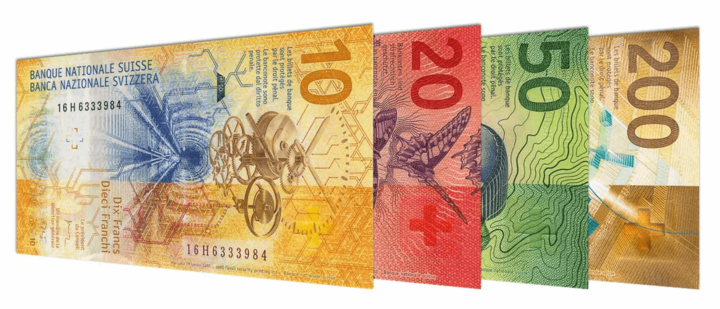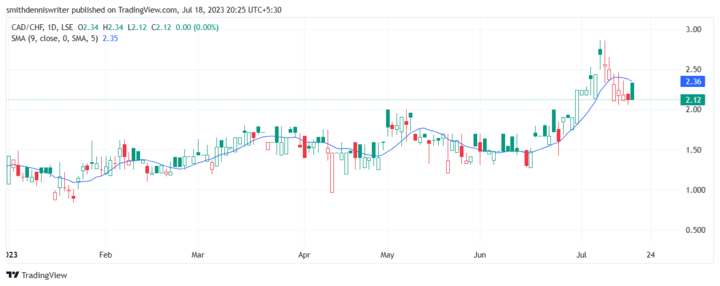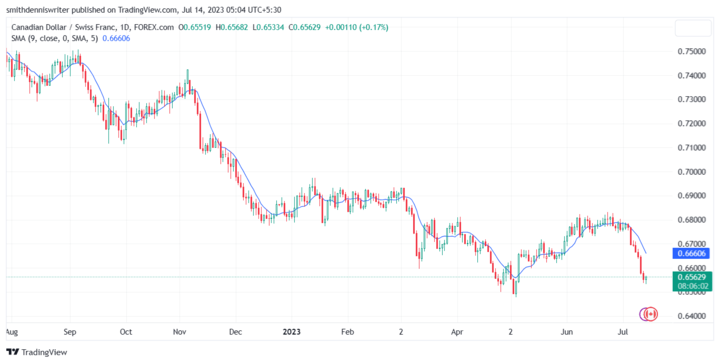I. Introduction
The CAD/CHF currency pair is an important pair in the forex market, representing the exchange rate between the Canadian Dollar (CAD) and the Swiss Franc (CHF). As one of the major currency pairs, it attracts the attention of traders and investors looking for opportunities in the forex market.
Fundamental analysis plays a crucial role in understanding the dynamics of the CAD/CHF currency pair. It involves evaluating the underlying economic, political, and financial factors that influence the value of these currencies. By examining key indicators and market drivers, fundamental analysis helps traders make informed decisions regarding the future direction of the pair.
The Canadian Dollar is the national currency of Canada and is driven by factors such as GDP growth, inflation rates, and monetary policy decisions made by the Bank of Canada. The Swiss Franc, on the other hand, is known for its stability and is influenced by Switzerland's economic performance, interest rates set by the Swiss National Bank, and global trade tensions.
Understanding the fundamentals of the Canadian Dollar and the Swiss Franc is essential to understanding the dynamics of the CAD/CHF currency pair and formulating effective trading strategies.
II. Macroeconomic Overview - Canada

Source: mint
A. Economic Indicators Review
Canada's economic performance is closely monitored to assess the health and potential of the CAD/CHF currency pair. Several key indicators provide insight into the country's economic landscape.
The Gross Domestic Product (GDP) is an important indicator that measures the overall economic output of Canada. It reflects the country's production, consumption, investment, and net exports. In addition, the unemployment rate indicates the percentage of the labor force that is unemployed. These indicators show the strength and stability of the Canadian economy.
In addition, inflation rates play an important role in shaping monetary policy and currency valuation. Tracking the Consumer Price Index (CPI) and other inflation measures helps to assess the purchasing power of the Canadian Dollar and its potential impact on the CAD/CHF exchange rate.
In addition, business and consumer confidence indices provide insight into the sentiment and outlook of businesses and individuals in the Canadian economy. Positive confidence levels can stimulate economic activity and influence demand for the Canadian Dollar.
According to the latest data from Statistics Canada, the inflation rate of Canada was 4.3% in March of 2023, up from 3.9% in February, as prices increased for gasoline, shelter, and food. The inflation rate was well above the Bank of Canada's target range of 1% to 3%. Consumer confidence in Canada improved to 91.7 in June of 2023, up from 88.8 in May, as consumers became more optimistic about the future of the economy and their personal finances. The consumer confidence index was still below its pre-pandemic level of 120.6 in February 2020.

Source: gettyimages
B. Monetary Policy
The Bank of Canada's monetary policy decisions have a profound impact on the Canadian dollar and, consequently, the CAD/CHF currency pair. The central bank's actions, such as adjusting interest rates, influence borrowing costs, inflation rates, and overall economic conditions. The Bank of Canada's monetary policy aims to keep inflation within a target range of 1% to 3% over the medium term. The Bank adjusts its policy rate, also known as the overnight rate, to influence short-term interest rates and borrowing costs in the economy.
The Bank of Canada closely monitors interest rate expectations to inform its decisions. Higher interest rates can attract foreign investment, strengthen the Canadian dollar and potentially affect the CAD/CHF exchange rate. In fact, the Bank of Canada has indicated that it will not raise its policy rate until inflation is sustainably within its target range, which it expects to happen in the second half of 2024.
C. Political Climate
The economic policies of the Canadian government play a vital role in shaping the country's economic environment. Policies related to fiscal stimulus, taxation, trade agreements, and infrastructure development can impact economic growth and currency valuation.
Additionally, the Canadian economy has a close relationship with the oil industry, making it sensitive to fluctuations in oil prices. As one of the major oil exporters, changes in oil prices can significantly affect the Canadian economy and subsequently influence the CAD/CHF currency pair.
Understanding the political climate and its impact on the Canadian economy is crucial for analyzing and predicting the performance of the CAD/CHF currency pair. Factors such as government policies and oil price dynamics must be carefully considered in fundamental analysis and trading decisions.
III. Macroeconomic Overview - Switzerland

Source: nationaltoday
A. Economic Indicators Review
To gain a comprehensive understanding of the CAD/CHF currency pair, it is essential to assess the macroeconomic indicators of Switzerland, the home currency of the Swiss franc (CHF).
The Gross Domestic Product (GDP) and unemployment rate provide insights into Switzerland's economic performance. The GDP measures the country's total economic output, reflecting factors such as production, consumption, investments, and net exports. Additionally, the unemployment rate indicates the proportion of the labor force that is currently unemployed, shedding light on the country's labor market conditions.
Inflation rates play a crucial role in monetary policy and currency valuation. Monitoring indicators such as the Consumer Price Index (CPI) helps to gauge the purchasing power of the Swiss franc and its potential impact on the CAD/CHF exchange rate.
Furthermore, business and consumer confidence indices offer valuable information on the sentiment and outlook of businesses and individuals in the Swiss economy. Positive confidence levels can indicate a robust economic environment and influence the demand for the Swiss franc.
According to the latest data, the unemployment rate of Switzerland decreased to 2.8% in June of 2023, from 2.9% in May, as the labor market continued to recover from the pandemic. The number of unemployed persons fell by 3,000 (-1.4%) to 212,000 in June 2023. The inflation rate of Switzerland was 1.5% in May of 2023, up from 1.2% in April, as prices increased for transportation, housing and energy, and recreation and culture.
The inflation rate was above the Swiss National Bank's (SNB) medium-term target of less than 2%, but still within its tolerance range of -1% to 3%. Consumer confidence in Switzerland improved to -5 in April of 2023, from -15 in January, as consumers became more optimistic about the general economic situation, their personal financial situation, and their ability to save. The consumer confidence index was above its long-term average of -9.

Source: gettyimages
B. Monetary Policy
The Swiss National Bank (SNB) is responsible for implementing monetary policy in Switzerland, which significantly impacts the Swiss franc and the CAD/CHF currency pair. The SNB's actions, such as interest rate decisions and interventions in the foreign exchange market, influence the value of the Swiss franc.
Monitoring interest rate expectations is crucial as it provides insight into the future direction of monetary policy. Changes in interest rates can affect borrowing costs, inflation rates, and ultimately influence the CAD/CHF exchange rate. The SNB has tightened its monetary policy further and raised its policy rate by 0.5 percentage points to 1.5% in March 2023, to counter a resurgence in inflationary pressures. The SNB has indicated that it cannot rule out the possibility that further increases in the policy rate will be necessary to ensure price stability over the medium term.
C. Political Climate
The economic policies pursued by the Swiss government play a vital role in shaping the country's economic environment. Policies related to fiscal discipline, taxation, trade agreements, and regulations can impact economic growth and currency valuation.
Moreover, global trade tensions can have a significant impact on the Swiss economy. Switzerland relies heavily on international trade, and disruptions or shifts in global trade dynamics can affect exports, economic growth, and the value of the Swiss franc.
Understanding the political climate and its influence on the Swiss economy is crucial for conducting a comprehensive fundamental analysis of the CAD/CHF currency pair. Factors such as government policies and the impact of global trade tensions need to be carefully considered when analyzing and predicting the performance of the pair.
For example, the commodity price index of Switzerland increased by 0.3% in May 2023 compared to the previous month, and by 5.6% compared to the same month of the previous year. The index stood at 109.1 points in May 2023 (December 2020 = 100). The increase was mainly driven by higher prices for energy products, food products, and basic metals.
IV. Analysis of the CHD/CHF Currency Pair
A. Relevant Economic Indicators
The CAD/CHF currency pair is influenced by various economic indicators and factors that shape the economies of Canada and Switzerland.
The correlation between the Canadian and Swiss economies plays a role in the CAD/CHF currency pair. While they have different economic structures, both countries are export-oriented and have strong ties to global trade. Understanding the interdependencies between the two economies can provide insights into the potential movements of the currency pair.
GDP growth, inflation rates, and interest rates are crucial indicators affecting the CAD/CHF exchange rate. Positive GDP growth in Canada can stimulate demand for the Canadian dollar, potentially strengthening the currency relative to the Swiss franc. Similarly, inflation rates and interest rates impact currency valuation. Higher inflation rates or rising interest rates in Canada may attract foreign investors, increasing demand for the Canadian dollar and influencing the CAD/CHF currency pair.
B. Factors Supporting a Bullish or Bearish Stance
The monetary policies of the Bank of Canada (BoC) and the Swiss National Bank (SNB) play a significant role in shaping the CAD/CHF currency pair. The BoC's monetary policy decisions, such as interest rate changes or quantitative easing measures, can impact the Canadian dollar's value. Similarly, the SNB's monetary policy, including interest rate decisions and interventions in the foreign exchange market, can affect the Swiss franc. Monitoring these central banks' actions and their stance on monetary policy is crucial for understanding potential movements in the currency pair.
Additionally, oil prices have a substantial impact on the Canadian dollar, as Canada is a major oil exporter. Fluctuations in oil prices can influence the CAD/CHF exchange rate. Furthermore, global trade tensions, such as those between the U.S. and China, can impact the Swiss franc due to Switzerland's export-oriented economy. Trade disruptions and shifts in global trade dynamics can affect the Swiss franc's value relative to the Canadian dollar.
C. Potential Risks for the CAD/CHF Currency Pair
Several risks can affect the CAD/CHF currency pair and should be considered when analyzing and trading it. Sudden changes in global economic growth can create volatility and uncertainty in currency markets, potentially impacting the CAD/CHF exchange rate. Economic downturns or recessions in major economies can lead to risk aversion and influence currency movements.
Unpredicted changes in Canadian or Swiss monetary policies can also pose risks. Unexpected shifts in interest rates, monetary stimulus, or policy statements by central banks can lead to significant currency movements and affect the CAD/CHF pair.
Geopolitical risks, such as trade tensions between the U.S. and China, can have spillover effects on the global economy and currency markets. These tensions can create volatility and uncertainty, impacting currencies including the Swiss franc and the Canadian dollar.
It is important for traders and investors to carefully assess and manage these risks when considering trading the CAD/CHF currency pair. Staying informed about global economic trends, central bank policies, and geopolitical developments is crucial for successful trading of this currency pair.
V. Trading Strategies for CAD/CHF
When trading the CAD/CHF currency pair, various strategies can be employed to identify potential trading opportunities and manage risks effectively.

Source: tradingview
A. Technical Analysis
Technical analysis involves studying historical price data and using chart patterns and indicators to forecast future price movements. From the graph below, the CAD/CHF pair has been in a downtrend since June 2023, as the Swiss franc has appreciated against the Canadian dollar due to its safe-haven status and the SNB's monetary policy tightening. The pair has broken below several support levels and trendlines, indicating a strong bearish momentum. The pair is currently trading near the 0.70 level, which is a psychological support level and also coincides with the 61.8% Fibonacci retracement of the uptrend from March 2020 to June 2023.
The moving averages are also confirming the downtrend, as the 50-day moving average (MA) is below the 200-day MA, and both are sloping downward. The pair has been trading below the 50-day MA since July 2023 and has faced resistance at this level several times. The pair has also crossed below the 200-day MA in September 2023, which is a bearish signal.

Traders who are bearish on the CAD/CHF pair may look for opportunities to sell on rallies, targeting the next support levels at 0.68 and 0.66. Traders who are bullish on the pair may wait for a clear reversal signal, such as a break above the 50-day or 200-day MA, before entering long positions. Traders should also be aware of the economic data and events that may affect the pair, such as GDP growth, inflation, interest rates, and the trade balance of both countries.
B. Risk Management
Risk management is a crucial aspect of successful trading. Traders should employ strategies to protect their capital and minimize potential losses.
Setting Stop-Loss and Take-Profit levels is a common risk management technique. A Stop-Loss order specifies a price level at which a trade will be automatically closed to limit potential losses. Take-Profit orders, on the other hand, specify a price level at which a trader intends to exit a trade to secure profits. By setting appropriate Stop-Loss and Take-Profit levels based on analysis and risk tolerance, traders can effectively manage their trades.
Determining position size based on risk tolerance is another essential risk management aspect. Traders should assess their risk tolerance and allocate an appropriate portion of their capital to each trade. This ensures that no single trade can significantly impact their overall portfolio and helps maintain a balanced risk-reward ratio.
C. News Trading
News trading involves monitoring economic events, data releases, and central bank announcements that can impact the CAD/CHF currency pair. Traders can capitalize on market reactions to the news by entering trades based on the anticipated market sentiment.
By following economic events such as GDP releases, interest rate decisions, or employment reports, traders can gauge the fundamental factors influencing the CAD/CHF pair. Trading based on market reactions to such news can provide short-term trading opportunities.
It is important to note that news trading requires a quick response and careful risk management. Volatility and rapid price movements can occur when significant news is released, and traders should be prepared to adapt their strategies accordingly.
Overall, combining technical analysis, risk management, and news trading strategies can help traders make informed decisions when trading the CAD/CHF currency pair. Implementing a well-rounded approach that considers both technical and fundamental factors is key to achieving consistent results in the forex market.
Trade CAD/CHF with VSTAR
VSTAR is a leading online trading platform that offers access to a wide range of financial instruments, including forex, stocks, commodities, indices, and cryptocurrencies. You can trade the CAD/CHF pair with VSTAR using advanced trading tools, such as technical analysis, indicators, charts, signals, and alerts. You can also benefit from low spreads, fast execution, high leverage, and 24/7 customer support. Whether you are a beginner or an expert trader, VSTAR can help you achieve your trading goals. Join VSTAR today and start trading the CAD/CHF pair with confidence and convenience.


VI. Conclusion
In this article, we conducted a fundamental analysis of the CAD/CHF currency pair, considering various economic indicators and factors that influence the Canadian dollar and Swiss franc. We examined GDP growth, inflation rates, interest rates, and the impact of monetary policies by the Bank of Canada and the Swiss National Bank. Additionally, we discussed the significance of the political climate, including government economic policies and the impact of global trade tensions on the Swiss economy.
Based on the analysis conducted, it is important to note that the CAD/CHF currency pair's outlook can vary based on prevailing economic conditions and market sentiment. The bullish or bearish stance of the pair depends on factors such as GDP growth, interest rate differentials, and the impact of geopolitical risks. It is essential to continually assess the dynamic nature of these factors and adjust trading strategies accordingly.
Trading the CAD/CHF currency pair requires a comprehensive understanding of both fundamental analysis and effective trading strategies. By considering economic indicators, monetary policies, and geopolitical risks, traders can make informed decisions. Incorporating technical analysis techniques can further enhance trading outcomes.
Ultimately, successful trading of the CAD/CHF currency pair requires a combination of fundamental analysis, technical analysis, risk management, and the ability to adapt to changing market conditions. By applying a disciplined and informed approach, traders can navigate the complexities of this currency pair and strive for favorable trading outcomes.

















